
The Book of Tobit is an apocryphal Jewish work from the 3rd or early 2nd century BCE which describes how God tests the faithful, responds to prayers, and protects the covenant community. It tells the story of two Israelite families, that of the blind Tobit in Nineveh and of the abandoned Sarah in Ecbatana. Tobit's son Tobias is sent to retrieve ten silver talents that Tobit once left in Rhages, a town in Media. Guided and aided by the angel Raphael he arrives in Ecbatana, where he meets Sarah. A demon named Asmodeus kills anyone she intends to marry, but with the aid of Raphael the demon is exorcised and Tobias and Sarah marry. Tobias and Sarah then return to Nineveh, where Tobit is cured of his blindness.

Gerbrand van den Eeckhout was a Dutch Golden Age painter and a favourite student of Rembrandt. He was also an etcher, an amateur poet, a collector and an adviser on art.
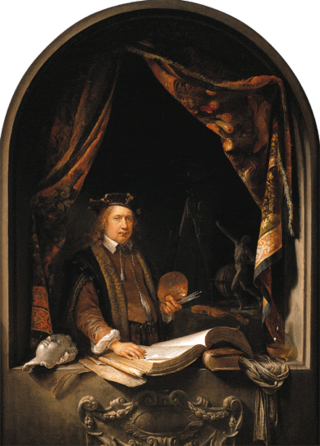
Gerrit Dou, also known as GerardDouw or Dow, was a Dutch Golden Age painter, whose small, highly polished paintings are typical of the Leiden fijnschilders. He specialised in genre scenes and is noted for his trompe-l'œil "niche" paintings and candlelit night-scenes with strong chiaroscuro. He was a student of Rembrandt.
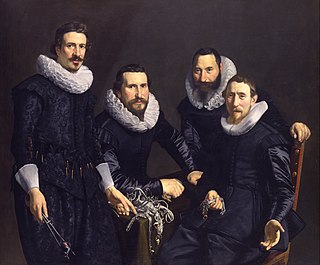
Thomas de Keyser was a Dutch portrait painter and a dealer in Belgium bluestone and stone mason. He was the most in-demand portrait painter in the Netherlands until the 1630s, when Rembrandt eclipsed him in popularity. Rembrandt was influenced by his work, and many of de Keyser's paintings were later falsely attributed to Rembrandt.

Ferdinand Bol was a Dutch painter, etcher and draftsman. Although his surviving work is rare, it displays Rembrandt's influence; like his master, Bol favored historical subjects, portraits, numerous self-portraits, and single figures in exotic finery.

Pieter Lastman (1583–1633) was a Dutch painter. Lastman is considered important because of his work as a painter of history pieces and because his pupils included Rembrandt and Jan Lievens. In his paintings Lastman paid careful attention to the faces, hands and feet.

Jan Lievens was a Dutch Golden Age painter who was associated with his close contemporary Rembrandt, a year older, in the early parts of their careers. They shared a birthplace in Leiden, training with Pieter Lastman in Amsterdam, where they shared a studio for about five years until 1631. Like Rembrandt he painted both portraits and history paintings, but unlike him Lievens' career took him away from Amsterdam to London, Antwerp, The Hague and Berlin.

Rembrandt Harmenszoon van Rijn, usually simply known as Rembrandt, was a Dutch Golden Age painter, printmaker, and draughtsman. He is generally considered one of the greatest visual artists in the history of art. It is estimated Rembrandt produced a total of about three hundred paintings, three hundred etchings, and two thousand drawings.

Hercules Pieterszoon Seghers or Segers was a Dutch painter and printmaker of the Dutch Golden Age. He has been called "the most inspired, experimental and original landscapist" of his period and an even more innovative printmaker.

Jan Victors or Fictor was a Dutch Golden Age painter mainly of history paintings of Biblical scenes, with some genre scenes. He may have been a pupil of Rembrandt. He probably died in the Dutch East Indies.
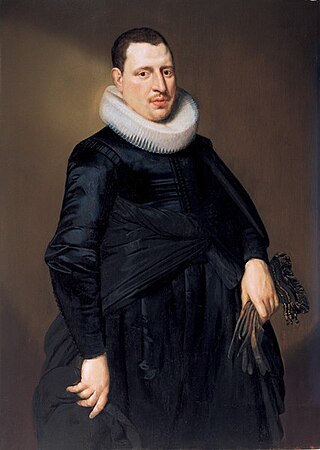
Cornelis van der Voort or van der Voorde was a Dutch portrait painter, art collector, art appraiser and art dealer from the early 17th century who was active in Amsterdam. He painted individual portraits as well as group portraits including schuttersstukken depicting local militia members and regentenstukken depicting regents of charitable institutions, a genre of which van der Voort was the inventor. He played an important role in the development of portrait painting in the early 17th-century Dutch Republic. He is particularly noted for introducing the life-size, full-length format to Dutch portraiture.
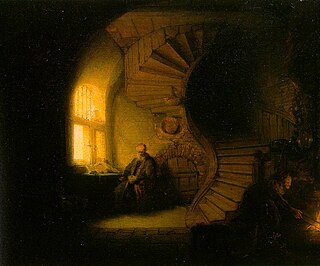
Philosopher in Meditation, recently renamed Philosopher in Contemplation by the museum, is the traditional title of an oil painting in the Musée du Louvre, Paris, that is attributed to the 17th-century Dutch artist Rembrandt.
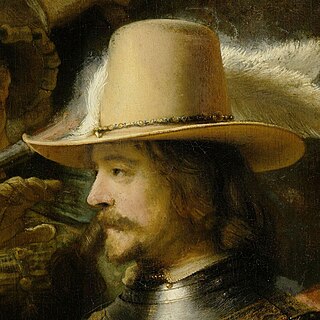
Willem van Ruytenburch, lord of Vlaardingen and Vlaardingen-Ambacht (1600–1652) was a member of the Dutch gentry and Amsterdam patriciate of the Dutch Golden Age. He became an alderman of Amsterdam and joined the Schutterij of Frans Banninck Cocq. Willem was featured, as a lieutenant, in Rembrandt's 1642 painting The Night Watch for which he is now probably most famous.

Self-portrait as the Apostle Paul is one of over 40 painted self-portraits by Rembrandt, painted in 1661 by the Dutch artist Rembrandt. It is now in the Rijksmuseum in Amsterdam.
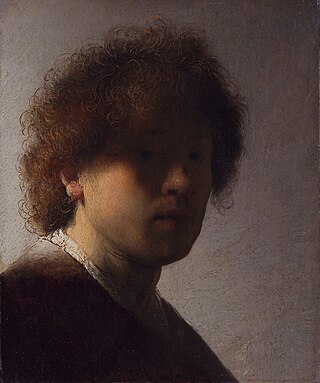
Self-Portrait with Dishevelled Hair, also known as Self-Portrait at an Early Age, is an early self-portrait by the Dutch Golden Age artist Rembrandt. The painting has been in the Rijksmuseum Amsterdam collection since 1960, and is an exercise in chiaroscuro. It is one of the earliest of over forty painted self-portraits by Rembrandt, there is a copy in the collection of the National Trust which was created by his workshop.
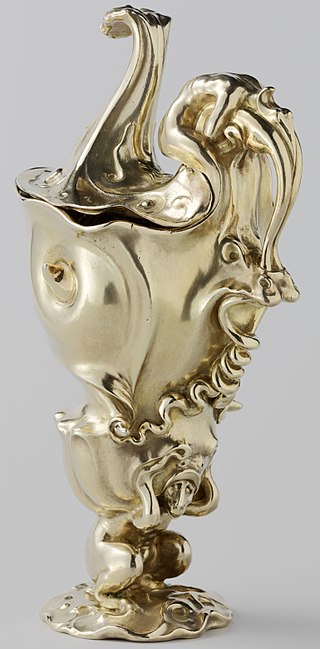
TheMemorial Guild Cupby Adam van Vianen is a 1614 silver-gilt covered ewer in the Rijksmuseum, commissioned by the Amsterdam goldsmiths' guild to commemorate the death of Adam's brother Paulus van Vianen. It is an iconic symbol of the auricular style developed by the two brothers.

The Archangel Raphael Leaving Tobias' Family is a 1637 oil-on-panel painting by Rembrandt, now in the Louvre, in Paris, France. The painting depicts a scene from the Book of Tobit, in which the archangel Raphael departs after guiding Tobias on his journey and helping to cure the blindness of his father, Tobit.

Abraham Serving the Three Angels is a 1646 oil-on-panel painting by Rembrandt. The scene depicts Abraham, it is based on an episode from the Book of Genesis and it has Mughal influence. Today it is in a private collection since it was bought in an auction in 1848 for £64. Before that its owners were Ferdinand Bol, a student of Rembrandt, the Dutch art collector and Mayor of Amsterdam, Jan Six as well as Benjamin West, an American artist.

Tobias' Journey is an oil-on-panel painting by Flemish artist Joos de Momper. The painting showcases Momper's large scale, imaginary landscape painting and his interpretation of perspective in distant views while at the same time treating a biblical subject. The painting depicts the story of Tobit, a righteous Israelite of the tribe of Naphtali, living in Nineveh, who is sent to recover is father's money to Media, escorted by the Archangel Raphael. The painting is currently housed at the Rockox House in Antwerp.

Anna and the Blind Tobit, also titled Blind Tobit and his Wife, is a c. 1630 oil painting by the Dutch Golden Age painter Rembrandt, and perhaps his pupil, Gerrit Dou. The picture hangs in room 22 of the National Gallery in London.































